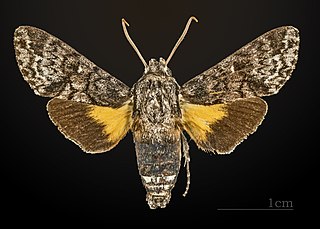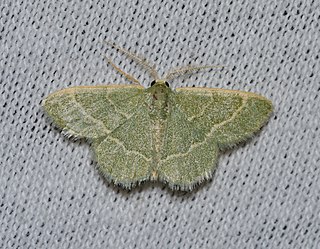
Laothoe populi, the poplar hawk-moth, is a moth of the family Sphingidae. The species was first described by Carl Linnaeus in his 1758 10th edition of Systema Naturae. It is found throughout the Palearctic region and the Near East and is one of the most common members of the family in the region. It is distinctive due to its habit of resting with its hindwings held further forward than the forewings.

The dryandra moth is a species of moth that is considered to be the sole member of the family Carthaeidae. Its closest relatives are the Saturniidae and it bears a resemblance to many species of that family, bearing prominent eyespots on all wings. The common name is derived from the Dryandra shrubs of the genus Banksia, on which the larva of this species feed, and is hence restricted to the south-west of Western Australia where these shrubs grow. Other Grevillea shrubs may also be used as host plants.

The Blastobasidae are a family of moths in the superfamily Gelechioidea. Its species can be found almost anywhere in the world, though in some places they are not native but introduced by humans. In some arrangements, these moths are included in the case-bearer family (Coleophoridae) as subfamily Blastobasinae. The Symmocidae are sometimes included in the Blastobasidae as subfamily or tribe.

Hippotion celerio, the vine hawk-moth or silver-striped hawk-moth, is a moth of the family Sphingidae. It was described by Carl Linnaeus in his 1758 10th edition of Systema Naturae.

Catocala ilia, the Ilia underwing, beloved underwing or wife underwing, is a moth of the family Erebidae. The species was first described by Pieter Cramer in 1776. It can be found in the eastern part of the United States as well as southern Canada. Subspecies Catocala ilia zoe can be found in California and Arizona.

The Erebidae are a family of moths in the superfamily Noctuoidea. The family is among the largest families of moths by species count and contains a wide variety of well-known macromoth groups. The family includes the underwings (Catocala); litter moths (Herminiinae); tiger, lichen, footman and wasp moths (Arctiinae); tussock moths (Lymantriinae), including the arctic woolly bear moth ; fruit-piercing moths ; micronoctuoid moths (Micronoctuini); snout moths (Hypeninae); and zales, though many of these common names can also refer to moths outside the Erebidae. Some of the erebid moths are called owlets.

Cautethia yucatana is a species of moth in the family Sphingidae, which is known from California and Mexico south to Central America. It was described by Benjamin Preston Clark in 1919.

Euproserpinus phaeton, the Phaeton primrose sphinx moth, is a moth of the family Sphingidae. the species was first described by Augustus Radcliffe Grote and Herbert C. Robinson in 1865. It is found in North America from California south to Baja California Sur and further into Mexico. It has also been reported in south-western Arizona.
Ethmia nadia is a moth in the family Depressariidae. It is found in California.
Ethmia discostrigella, the mountain-mahogany moth, is a moth in the family Depressariidae. It is found from the western United States, south into Mexico.

Ethmia monticola, the gray ethmia moth, is a moth in the family Depressariidae. It is found in North America from British Columbia and Alberta to California and Arizona, east at least to North Dakota and Colorado.

Adela thorpella is a moth of the Adelidae family or fairy longhorn moths. It was described by Powell in 1969. It is found in California.

Adela trigrapha is a moth of the family Adelidae or fairy longhorn moths. It was described by Zeller in 1876 and is found in western North America, from Vancouver Island to California.

Cnephasia longana, the omnivorous leaftier moth, long-winged shade or strawberry fruitworm, is a moth of the family Tortricidae. It was described by Adrian Hardy Haworth in 1811. It is native to western Europe. It is an introduced species in western North America. The species has also been reported from north-western Africa and Asia. The habitat consists of downland and rough ground.

Chionodes mediofuscella, the black-smudged chionodes moth, is a moth of the family Gelechiidae. It is found in North America, where it has been recorded from Nova Scotia to Florida and from British Columbia to Colorado, Arizona and northern California.

Chlorochlamys phyllinaria, the thin-lined chlorochlamys moth, is a moth of the family Geometridae. It is found in North America, where it has been recorded from Georgia to California, northward in the central states to Nebraska.

Conchylodes octonalis, the eight-barred lygropia moth, is a snout moth in the family Crambidae. It was described by Zeller in 1873. It is found in North America, where it has been recorded from central and southern California to Texas and from Iowa, Mississippi, Nevada, New Mexico, Oklahoma and Tennessee. The habitat consists of low-elevation arid areas.

Scrobipalpa instabilella, the saltern groundling, is a moth in the family Gelechiidae. It was described by John William Douglas in 1846. It is found in on the Canary Islands, in Algeria, Ireland, Great Britain, Portugal, Spain, France, Belgium, the Netherlands, Germany, Denmark, Italy, Sardinia, Sicily, Greece, Cyprus and Palestine. It is also present in the United States, where it has been recorded from California.

Anacampsis niveopulvella, commonly known as the pale-headed aspen leafroller moth, is a species of moth in the family Gelechiidae. It was first described by Vactor Tousey Chambers in 1875. It is found in North America, where it has been recorded from Alberta, Arizona, British Columbia, California, Indiana, Maine, Manitoba and Ontario.

Neopalpa donaldtrumpi is a moth species of the genus Neopalpa occurring in Southern California and Northern Mexico. It was described in 2017 by Iranian-Canadian scientist Vazrick Nazari. Known for its yellowish-white head scales being reminiscent of Donald Trump's hair, the moth was given its name because Nazari stated that he wanted "to bring wider public attention to the need to continue protecting fragile habitats in the US that still contain many undescribed species."

















